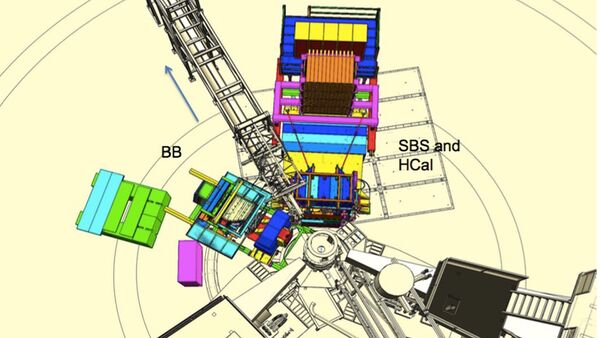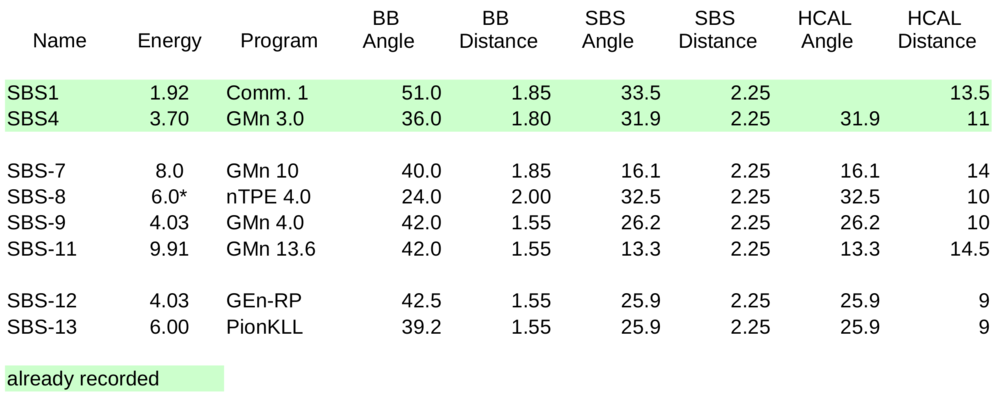Run Coordinator Training GMn
<< SBS Main<<Run Coordinators
This is the repository of information relevant to Run Coordinators.
Contents
Experimental Overview
The GMn set of experiments is a set of 4 experiments set to run in late 2021 and early 2022 in Hall A. The experiments will utilize the SuperBigBite spectrometer(SBS) on beam right to detect the scattered hadrons while the BigBite spectrometer (BB) on beam left detects the scattered electrons (see diagram in Figure-1). GMn will take most of the time with each of the other three experiments requiring only a few days each of data taking.
- GMn (E12-09-019): measuring ratio of the neutron to proton elastic scattering rates to extract neutron magnetic form factor at 𝑄^2 as high as 13.3 𝐺𝑒𝑉^2 −more than triple the existing 𝑄^2 value. This experiment runs all through the Fall of 2021 with a small interruption for nTPE.
- nTPE (E12-20-010): measuring ratio of neutron to proton scattering rate at same 𝑄^2=4.0 𝐺𝑒𝑉^2 as GMn but different beam energy and scattering angles allowing extraction of ”Rosenbluth slope” and neutron magnetic form factor via LT separation. This is the first experiment use LT separation from neutron and will provide first measurement of two photon exchange contribution to neutron magnetic form factor.
- GEn-RP (E12-17-004): measuring the electric form factor of the neutron, GEn, by measuring the polarization of the recoiling neutron at 𝑄^2=4.1 𝐺𝑒𝑉^2− more than twice the 𝑄^2 of previous highest measurement on deuterium target (HallC). This experiment is expected to run polarized beam during Jan. 2022.
- Pion KLL(E12-20-008 ): measuring polarization transfer from photon to proton in wide angle pion photo-production. Attempts to calculate pion photoproduction cross section in the past were off by ~100 until a recent solution was published. Measurement of polarization observables will check predictions of this new calculation approach. This experiment is expected to run polarized beam during Jan. 2022.
GMn has several proposed kinematic points with different spectrometer angles and offset distances from the target. The proposed kinematics as of Oct 20, 2021 are shown in the table below in Figure-2. These are subject to modification. Plans are in flux and constantly changing as needs demand. Make sure to request the kinematics spreadsheet from Bogdan or another spokesperson for the kinematics setting(s) assigned to your week. Post them on the Main Page of the wiki along with the others already there.
Your responsibilities
Please familiarize yourself with the role/duties of the RC outlined in the COO (pg. 4-6 [1]). Occasionally there is a gray area where the duties of RC and that of the crew chief and program deputy (PD) overlap. In these cases strong communication is key. One example of this is arranging a hall sweep with Radcon. While in the COO it appears to be in the purvue of the RC to directly arrange this with Radcon, occasionally a more hands-on PD will give you grief for doing so, since the resources of Radcon are limited and the PD may prefer to allocate these personally. Good communication of your activities with the PD and crew chief at least where those activities have impact beyond the hall helps when encountering gray areas of overlapping responsibilities.
NOTE: these experiments have many different kinematic settings and as our runtime is reduced, the schedule is re-arranged. Some kinematic points are canceled and others prioritized. When this happens, you as the RC must make sure communication is healthy. Sometimes communication assumed to be happening through the proper official channels does not happen as it should. Make sure that all plans and changes communicated to you through the spokespeople have been approved by the Hall leadership (Mark Jones at this time) and have been communicated (and approved by) to the accelerator physics liason (Yves Roblin) and the current Program Deputy (PD).
Remember to assert the leadership of your position. This is not about control but about safe and efficient operations. No one in the collaboration, Hall or accelerator staff or even experimental spokespersons should circumvent the proper line of communication and coordination through you as RC. Enforce this! Once the experiment has started, control of the Hall is no longer in the hands of the work coordinator, but is now with the RC. All work in the Hall during Controlled Access must be coordinated through you. If someone is in the hall, you should know what they are doing because they already were in communication with you. Even remote work should usually be coordinated with the RC. For example, having collaborators outside the counting house using the DAQ for tests when the RC expects the shift crew to be taking data should not happen. This probably means someone has not communicated with you to coordinate their studies. Another problem example scenario might be a system expert ramping up the HV on their subsystem for testing during Controlled Access without notifying the RC, thinking it won't impact anyone else. You as RC, however, might know that hall techs are working in the area and no HV is allowed to be turned on. Encourage the collaboration to communicate all appropriate activities through you.
Communicating with spokespersons
Communicating with the spokespersons is key. Generally speaking, major program changes or decisions should have input from all the spokespersons. However, you may find that for day-to-day operations regular communications with the most active onsite spokesperson is sufficient.
Bogdan W. is a spokesperson on all 4 experiments (GMn, nTPE, GEn-RP, and Pion KLL). He is onsite much of the time and can usually be reached quickly by email bogdanw@jlab.org. His office number is x7191.
- GMn
- Brian Quinn is a spokesperson on GMn. He can be reached by phone(412) 915-1739 or email bquinn@cmu.edu
- Alexandre Camsonne is a spokesperson on the GMn experiment. He can be reached at almost any time of day or night on the Slack SBS workspace. He can also be reached by phone at (757) 260-5064 or email at camsonne@jlab.org.
- David Hamilton is a spokesperson on GMn. He can be reached at david.j.hamilton@glasgow.ac.uk.
- GEn-RP
- Brad Sawatzky is a spokesperson on GEn-RP. He can be reached at x5947 or brads@jlab.org.
- Pion KLL
- John Arrington is a spokesperson on Pion KLL.
- Andrew Puckett is a spokesperson on Pion KLL and is the optics/software go-to person. He can be reached at puckett@jlab.org or on the Slack SBS workspace.
- Arun Tadepalli is a spokesperson on Pion KLL. He can be reached at (757) 269-6989, on the Slack SBS workspace, or arunts@jlab.org.
- nTPE
- Sheren Alsalmi is a spokesperson in nTPE.
- Eric Fuchey is a spokesperson on nTPE. He can be reached on the Slack SBS workspace or via email at efuchey@jlab.org
Specifics you should know
- Whenever the Hall goes into Controlled or Restricted Access, SBS and BigBite spectrometer magnets should be ramped down. MCC controls SBS, we control BigBite. Read the Hall transition procedure.
- Familiarize yourself with the various trigger configurations from the How Tos and how to set them with the pre-scale GUI. Usually, during production, the trigger is set to trigger on BigBite (ps1=0,ps2=-1,ps3=-1,ps4=-1,ps5=4 (approximately),ps6=0,ps7=-1,ps8=-1).
- The DAQ is currently limited to about 5 kHz event rate. This may need to be updated as things are improved. Ask Andrew Puckett if you suspect this is not up to date. Above 5 kHz the live time goes down exponentially. You may need to experiment with the current at each setting to find the optimal point at which to run to maximize the event rate. The live time should be above 90%. The BigBite trigger rate and the Level 1 Accept (L1A) rate can be read from the scaler GUI and are labelled TS1-BB and L1A on the BCM tab.
- There are fairly well documented procedures for bring beam into the Hall that provide a good starting point (see Run_Plan_for_4-pass_Setup for example). Modify these as necessary. For the most part, these are sufficiently well documented that the shift crew can do these independently. There are more detailed instructions listed at Establishing_beam_in_the_Hall and SBS_spot++_(beam_size_verification). If you have questions or issues, you should contact Donald Jones and/or David Flay. Experience dictates that bringing beam into the Hall at a new energy can be a time consuming experience, so as RC, rely on these experts and at your own judgment, instruct the shift crew to call them rather than the RC phone for help with this procedure if it is after hours so that you can get much needed rest.
- The shift crew should keep the run log spreadsheet up to date. Edit this to add additional kinematic points as needed.

